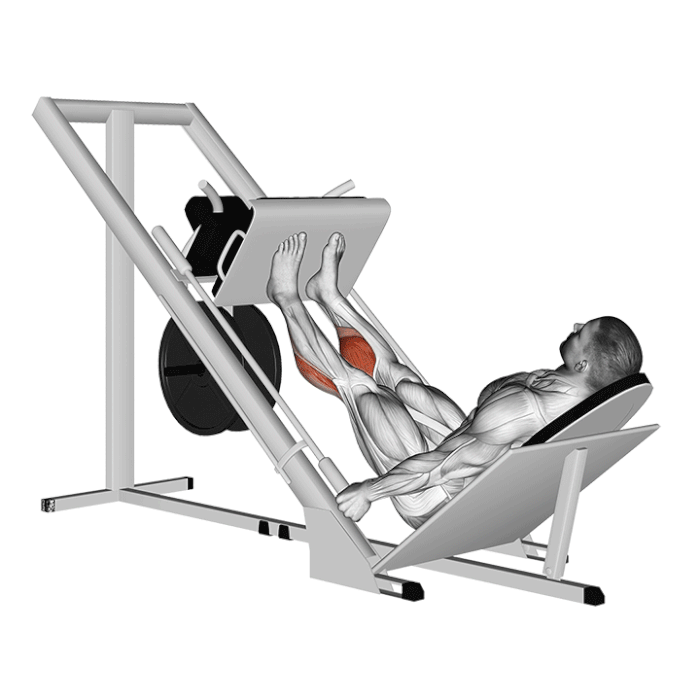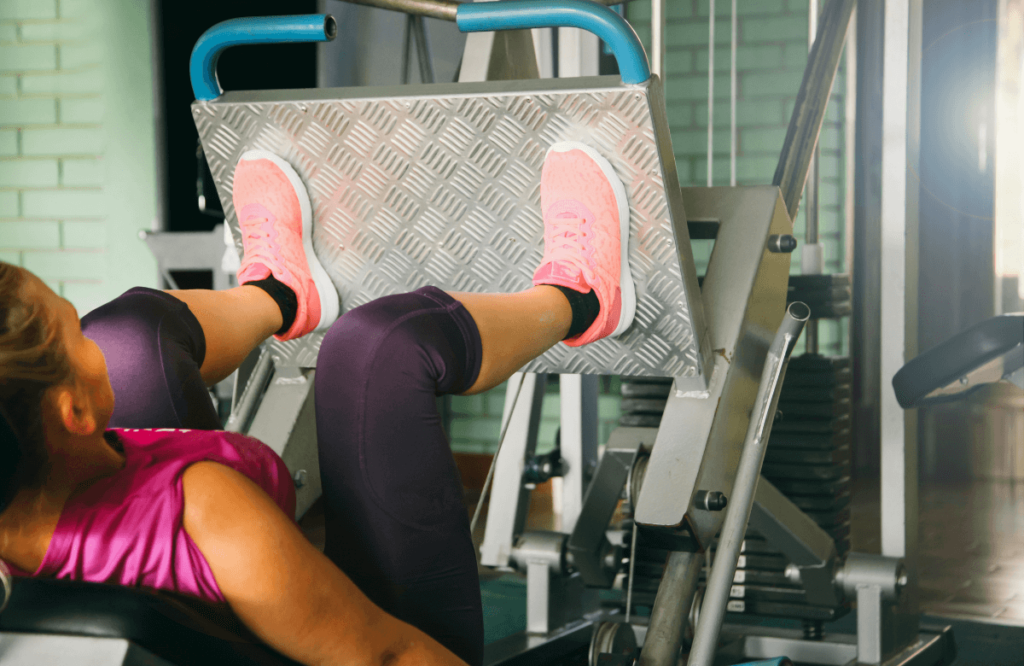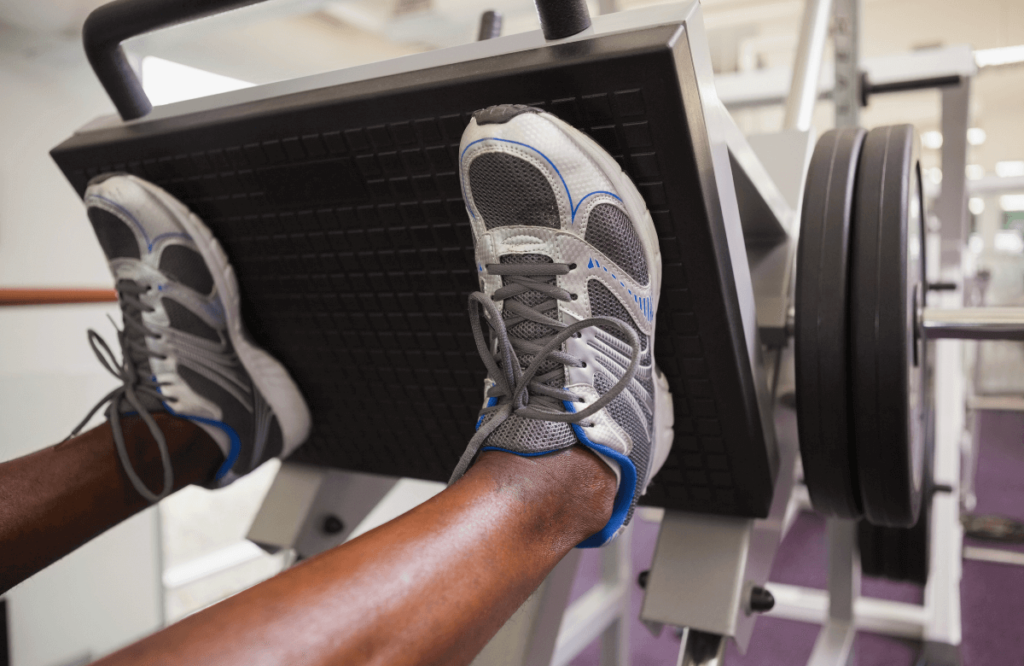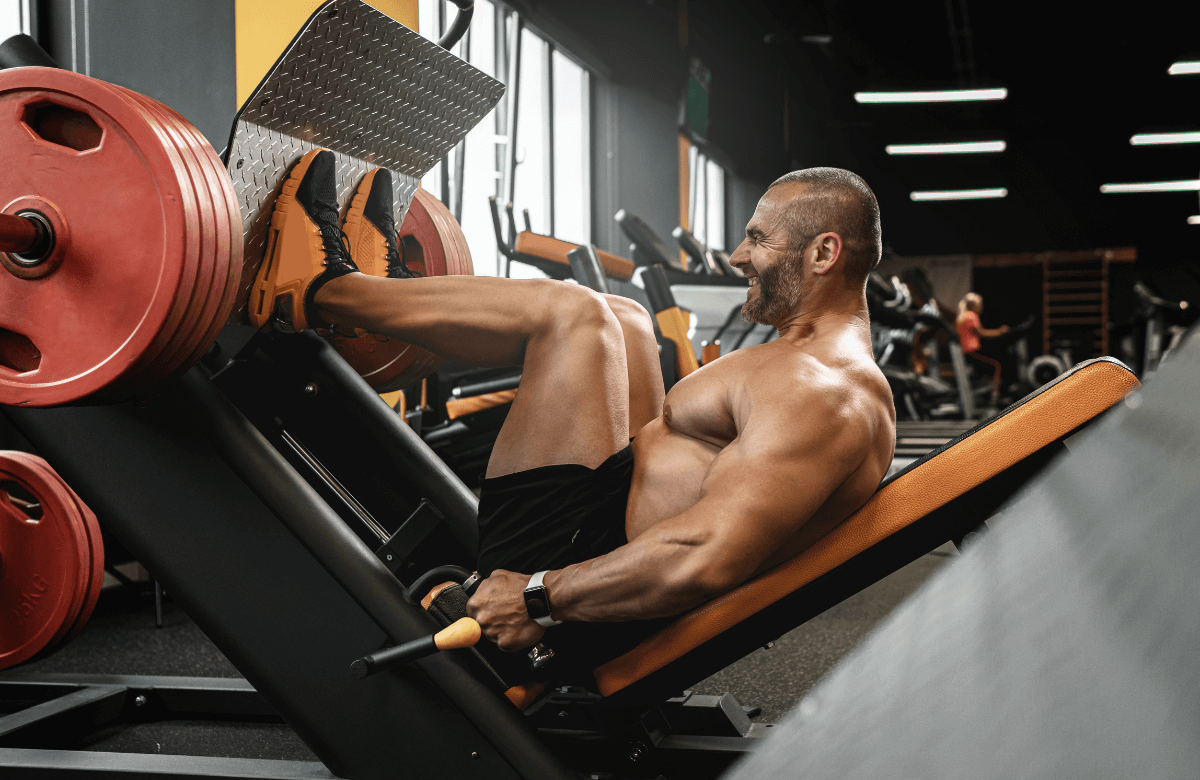The leg press machines are very popular in commercial gyms, but many newbie fitness folks don’t know that each leg press machine (depending on brand and kind of machine) has a different weight to it. Meaning, you might be putting on a hundred pounds of plates, but there could be an extra fifty pounds from the machine you’re on and you’d have no idea.
In this article we’re going to go over the different leg press weights, how to use them, the benefits, where to start, what your rep count should be, and so much more. We even give some beginner to advance advice you won’t want to miss out on. So read on!
Jump to:
What Is A Leg Press?
A leg press is basically a weighted machine that you can sit in and push against it with your feet to provide great feedback to your leg muscles.
The two machines commonly found in gyms and home gyms are the standard horizontal leg press and the 45-degree leg press, with a seat that reclines at an angle while your legs press upward in a diagonal direction.
Both machines help develop the quadriceps and hamstring muscles of the thigh and the gluteus maximus. While it looks quite simple, paying attention to your form and learning about each variation of the machine can help maximize the strength-building benefits and prevent injury.

How to Use It
Start by sitting on the seat with no weight and place your feet hips-width apart on the footplate. Once your feet are in place and you’re comfortable, press the footplate with both feet as you simultaneously disengage the safety latches on the side of the seat with your hands.
With your feet still on the footplate, bend your knees, letting the footplate come toward your body. When your knees are at a 90-degree angle, press the footplate back up and straighten your legs while making sure not to lock your knees. This counts as one rep. If you’re okay with adding more weight, add it, and then continue your set until finished. Once you’ve completed your set, press the footplate and engage the safety latches.
Now, different machines will look slightly different, but for the most part, they all function pretty similarly so if you’re confused refer back to the basics or ask a gym goer or google for advice for your specific machine.

How Much Is The Leg Press Machine Without Weight?
The leg press is no doubt a popular exercise for leg day, but how do you know how much weight you’re actually lifting when some of the leg press machines have different weights? We got you! We put together a list of almost all of the leg press machines you’ll find at the gyms and documented their typical weight to help you determine how much you’re actually lifting.
Let’s start with the…
Angled Plate-Loaded Leg Press
One of the most common leg presses is the angled plate-loaded leg press. It has a seat near the floor and a carriage or sled mounted on 45-degree angled rails that allow you to increase the resistance by adding weight plates on either side of it.
Here are some of the most common leg press machine brands and their weights:
Life Fitness103 lb (47 kg)
Hammer Strength118 lb (54 kg)
Cybex125 lb (57 kg)
Precor136 lb (62 kg)
Matrix167 lb ( 76 kg)
Pivot Leg Press (Squat Press)
The squat press, another type of plate-loaded leg press, also known as the pivot leg press, is only different because the foot platform is not on an angle like a traditional leg press. Instead, the platform attaches to lever arms that rotate around a pivot point to create a more natural movement path. that results in variable resistance that feels lighter at the bottom and heavier at the top.
The starting load is most likely around 5-30 lbs, however, based on the design mechanics there is no guarantee since manufacturers don’t typically have a starting weight for these machines.
Hack Squat
The hack squat is basically an upside-down angled leg press where the foot platform is at the bottom, and the back/shoulder pads are at the top. The hack squat starting weight is usually 80-105 lbs, which is slightly less than the starting weight for the average angled leg press. With that said, the hack squat feels much heavier because you must also lift more of your body weight compared to the leg press by placing more load on the quads while reducing the involvement of the larger glute and hamstring muscles.
The main benefit of the hack squat machine is that your back stays relatively upright during the movement, which means less hip bend and more knee bend, making it better for targeting your quads.
Machine Leg Press
To provide resistance, the leg press machine uses a weight selector stack and cables (or belts). Most of these machines move horizontally or at a shallow angle and like other leg press exercises, you sit in the seat with your feet against the foot platform to push.
The starting weight of a machine leg press is typically around 20 lbs, but this depends on how low the weight stack goes and the initial resistance of the seat or foot platform.

Beginner Lifters
The first thing you need to do is figure out the average leg press weight to start with. If you have never been on a leg press machine we recommend starting with about 50 percent of what you imagine you’d be capable of pressing and then going up from there.
So if you think you can leg press 100lbs then drop that down to 50lbs. However, some people are very unrealistic so a good guideline is to start with a weight that’s about 50 to 75 percent of your body weight, meaning if you’re 180lbs you should start at around 90 lbs and don’t forget to take the weight of the machine into consideration as well.
Intermediate and Advanced Lifters
Advanced lifters can typically end up being able to lift four or five times their body weight, but that takes time and lots of practice.
A few things more experienced lifters can start doing is playing with foot placement. For example, a high and wide foot placement can help you target your glute muscles while a narrow stance focuses on your quads. You can also incorporate different breathing techniques and continue to try different machines to see what works best for your fitness goals.
Though because some leg press machines have some extra weight in the carriage(some can have 45 pounds or more) maybe do a few weight-free reps to know what to expect before adding up your plates.

How Much Weight Should I Add And What Should My Rep Count Be?
Once the weight and rep range start to feel comfortable, you can increase your weight by adding small increments of weight each set or workout.
If you’re looking to build muscular endurance (which is especially helpful if you play a sport or are a professional athlete), you can increase your reps to 20 to 30 in sets of 4 or 5. Now, if you’re training for hypertrophy (increased muscle size), you can keep your total reps low at no more than 6 to 8 sets at 3 to 4 sets. With hypertrophy, you’ll want lower reps and set, but this means you can increase your weight more quickly.
Your goal is to aim for 50 to 75 percent body weight at first, but progressively you’ll want to add weight and that number will change depending on how often you workout, your diet, and even your stress levels. Some people can add 5 to 10 lbs every week while others can find themselves adding 20 lbs in the same time period. As long as you’re not adding too much weight that you can’t ever finish your set, you should be alright.
The Benefits:
This machine is very good at building those quadriceps, the gluteus maximus, hamstrings, and calves. It also lets you emphasize different muscles by varying your foot position and helps you overcome imbalances, such as overdeveloped hamstrings, compared to quadriceps.
Reduced Stress On The Body
Although the leg press machine mimics the barbell squat, it really reduces the force on your core, making it less of a full-body exercise. This is a great exercise to pair with squats since it will allow you to continue without causing the additional fatigue that loading a barbell on your spine creates.
Boost Squat Performance
By strengthening your quadriceps you can increase squat performance. If you have found that you have reached a strength plateau with your barbell squat, adding the leg press may really help.
Increased Balance And Stability
Some people are not ready to use a barbell for squatting until they are accustomed to lifting heavy weights with their legs in a way that increases balance and stability, which is where the leg press machine comes in. It allows you to lift the same weight you would with a barbell but with more balance and stability of the core and legs in the safest way possible.













